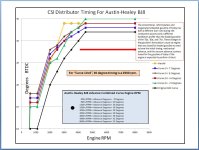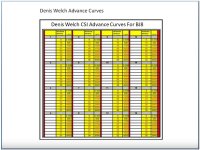Manchester study on modern fuel burn rates: "The conventional, reformulated, and oxygenated unleaded gasoline of today has both a different burn rate during the combustion process and a different distillation profile than the leaded gasoline of the '50s, '60s, and '70s. These changes in the current gasoline formulation cause an engine that was tuned for leaded gasoline to need to have the initial timing, mechanical advance, and the vacuum advance systems tuned for the gasoline of today (requires more advance) if the engine is expected to perform its best."
Below are recommendations from Denis Welch (base curves 9-12 referenced are from the Denis Welch CSI distributor). I am using Denis Welch Curve 10 with the addition of 6 degrees initial timing. This resultant timing is the red curve in the graph.
"Denis Welch – The best starting point for installation of the CSI distributor in a BJ8 is one of our curves 9-12. We usually use 15 to 18 degrees static tuning to setup the CSI Distributor, not the 10 degrees mentioned in the installation manual. Make sure the vacuum advance is off when the strobe is used to check the timing as with the stock distributor. Check the timing at 1000 RPM (15 to 18 degrees) and then again at 3000 RPM (about 32 degrees). From 3000 RPM to 4500 RPM, we look for a timing advance of 32 degrees to 35 degrees respectively."

 Hi Guest!
Hi Guest!

 smilie in place of the real @
smilie in place of the real @
 Pretty Please - add it to our Events forum(s) and add to the calendar! >>
Pretty Please - add it to our Events forum(s) and add to the calendar! >> 


